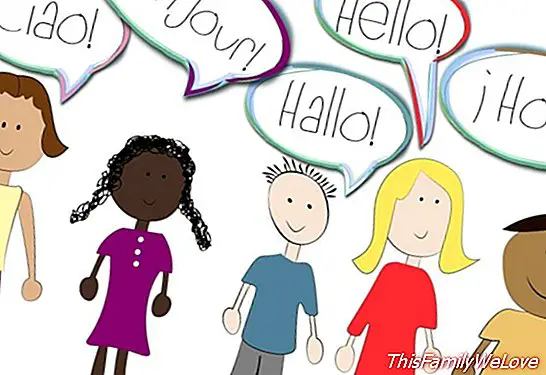Bilingual children: ideas to learn two simultaneous languages

Among the many potentials that children treasure, the facility to learn languages It is undoubtedly one of the most lucid. Without apparently making any effort, they are able to begin to chirp in two languages before the amazed - and somewhat envious - eyes of the adults. How is it possible that in just a few months they can learn what we had to study for years? Can we facilitate that learning? Or can it harm them to challenge the Tower of Babel?
Apart from the autonomous languages, whose teaching is institutionalized, many parents consider starting their child in a second language as soon as possible.
However, although advantages of bilingualism they are clear, there are few cases in which a family can transmit to a child two languages at a time. This is because to achieve it perfectly, it would be necessary that Some of the parents will contribute a different mother tongue or live in a foreign country. Generally, not only do they both speak the same language, but also, it coincides with the environment in which they live.
However, what can be available to many families is to provide the child with stimuli that help him or her to become familiar with the child. accent of that language.
Bilingual children: childhood the best time to learn languages
Between 1 and 4 years, babies and children are in the middle of a sensitive period for learning languages. The ideal, therefore, would be to be able to offer a bilingual education, but if we do not meet the requirements, we should not throw in the towel either.
When trying to hear English or another second language, we are accustomed to distinguish absent sounds in the Spanish language and, therefore, we will be helping you not to speak with an accent in the future.
In addition, the mental exercise that involves understanding and, where appropriate, also speaking, two grammatical structures and two different vocabularies, favors the creation of new neuronal connections. That is, it is a very clear path of early stimulation.
Disadvantages of learning two simultaneous languages for children
Despite its many advantages, however, simultaneous learning of two languages can have some drawbacks.
One of them may be that the child takes a little longer to let go and talk. This delay, which only affects speech but not comprehension, will be overcome soon, and at 4 or 6 years it will be at the normal level.
It may also be the case that we confuse the child, if we mix the two languages when speaking with him. Not only will we not be able to be bilingual, but we will probably delay you in learning your own language.
The temptation to speak at home in a second language
In some families, sometimes one of the two parents masters a language quite well, in addition to its mother tongue. This can provoke the temptation to speak to the children in that language, thinking that this way we help them to get familiar with it.
But the truth is that this practice is not usually very appropriate. First, because the child learns from an adult that, probably, he will pronounce with an accent. And, secondly, because this practice will make noticeably decrease the richness of communication between father and son.
However correct his command of that foreign language may be, the father will express himself in a language different from his mother tongue and the message will be, therefore, colder. So, instead of "how cool", say "I like it very much" and, although it seems somewhat banal, the truth is that to detract from a very important facet in the education of children as is communication.
The preferable thing is that this communication is always done in the parents' native language, although this supposes having to use alternative methods so that the child learns a second language.
Bilingualism: to take into account
A language can not be separated from the way of speaking and feeling of culture accompany him If we do not take this factor into account, our son probably will not only become bilingual, but his learning will be artificial and not very enriching.
To achieve this combination-to transmit language and culture at the same time-it is necessary for each person to speak to the child in their own mother tongue, and not to confuse him speaking in different languages according to the circumstances.
At these early ages, It does not make sense to "teach" the child the rules of a language, why learn naturally, just as it does with Spanish: listening to those who dominate it and talking about age-related errors.
María Moll
Advisor: Beatriz Bengoechea. Psychologist and family counselor




